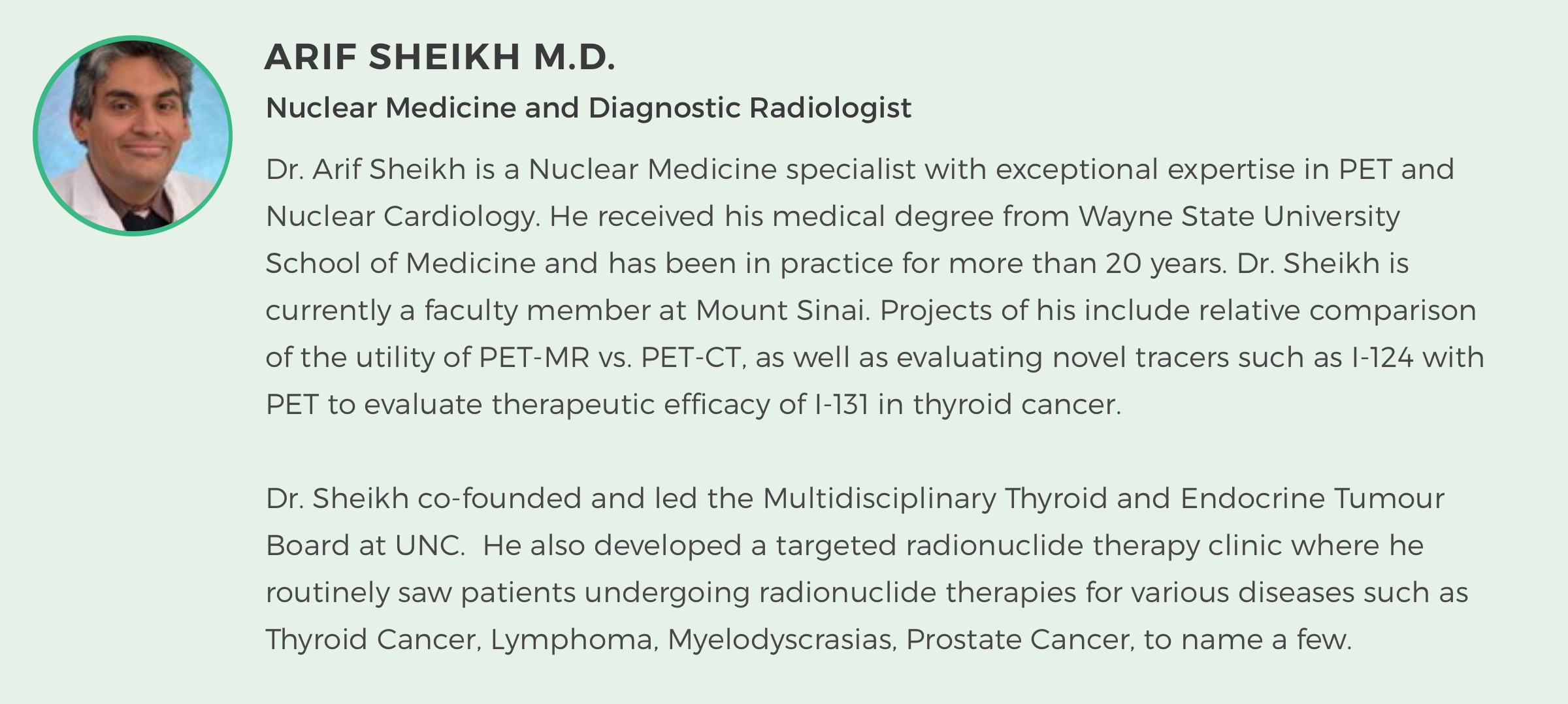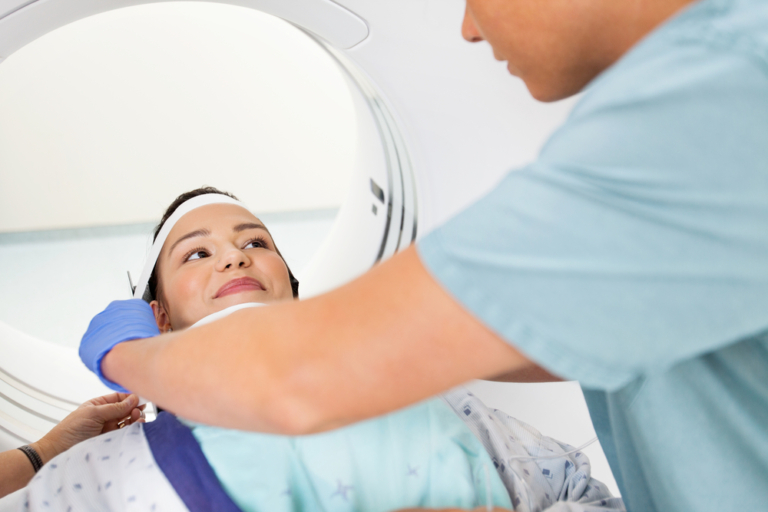A type of nuclear scan, PET (positron emission tomography) allows radiologists to examine organ behavior so that they can better identify, stage, and treat disease. But given the complexity of a nuclear scan, image interpretation can be challenging. When reading a PET scan, accuracy relies heavily on the skill of the radiologist.
We spoke with Dr. Arif Sheikh, a lead nuclear medicine expert at DocPanel and Mount Sinai faculty member, to discuss the role image interpretation plays in PET scan accuracy. From the advantages of a nuclear scan to how patients can make sure their scans are read by qualified radiologists, Dr. Sheikh shares valuable advice.
DocPanel is committed to making sure every patient gets an accurate diagnosis. If you would like an expert second opinion on your medical imaging scan from Dr. Sheikh or one of our other subspecialists, you can learn more here.
[DocPanel] What makes PET scan interpretation so complex?
[Dr. Sheikh]
While there is some role of a nuclear scan as a front line diagnostic tool, it is generally used in conjunction with other scans. In fact, most machines in nuclear medicine are now hybrid machines, including PET/CT, Spect/CT, and PET/MR. (The most common being PET/CT.)
So for the radiologist, you’re not just reading one type of scan. You’re reading several types – and you’re not just reading them individually, you need to also know how to interpret them together in order to ensure the PET scan is accurately taken into consdideration.
For example, with an FDG PET/CT – we need to interpret the CT scan, PET scan, and PET/CT. So we’re essentially reading three scans. Without proper training, one may lack the ability to correlate PET results with findings on a CT or MRI. This increases the risk of a misdiagnosis.
[DocPanel] What are some potential pitfalls that could compromise PET scan accuracy?
[Dr. Sheikh]
Every modality has its advantages and its pitfalls. For instance, a CT or MRI scan might show certain findings that look abnormal. But on an FDG PET scan, the area may look completely normal. That doesn’t automatically mean there’s no cancer. The same goes for the versus circumstance.
The two tests are complimentary together and that’s where the nuance comes in – because the interpretation is not just based on one over the other. It involves taking the information, combining it, and then looking at it collectively to say – ok, what does this best tell me given the overall results? You have to put the two together.
Now, of course, there’s some nuance in all image interpretation. It’s just significantly heightened for PET. And one has to be really familiar with the nuclear scan component to understand what that nuance is. It’s very tempting to look at the CT or MRI and just kinda add on the PET instead of taking the nuanced interpretation of combining the data to draw a cumulative interpretation.
[DocPanel] How does training impact a radiologist’s ability to read PET scans accurately?
[Dr. Sheikh]
Many non-radiologists read radiology scans that they are not specifically trained to read. For example, a neurologist might frequently read neuro CT and MRI scans. In such cases, they’re looking at the images to extract specific information – which is okay in some instances because it helps them manage the patient. However, you have to be careful because nowadays radiology is becoming more and more complex.
To become a radiologist, there is a standard level of training you have to complete to practice as a general radiologist. Many people then go on to complete more specific training to become a subspecialty radiologist with a focus on a particular body part, body structure, or type of modality (i.e. MRI, ultrasound, etc).
If you have a general radiologist reading a PET scan, they are probably proficient in reading at say, a 70-80 percent complexity level. While they’re probably pretty good at picking up obvious findings, the nuances are not there.
Learning how to read nuclear scan results is a skill that is developed with training in nuclear medicine. There’s a lot of nuance in these reports. One has to specialize in PET (nuclear medicine) and have read a lot of scans to understand all the variables and intricacies. You need someone who is well versed in new techniques and who is familiar with the different ways disease presents itself on a nuclear scan and regular imaging.
CONNECT WITH A SPECIALIST
Get a Second Opinion
Take charge of your health with an online second opinion from a radiology specialist.
[DocPanel] What are some of the major advantages of PET and other nuclear scans?
[Dr. Sheikh]
With a nuclear scan, accuracy goes far beyond disease detection. It also influences patient outcomes during and after the treatment phase.
A nuclear scan is typically used after an abnormality has already been found on CT or MRI. Because of its unique ability to pick up disease that is hiding in normal-looking tissue, it helps us further characterize the abnormality so that we can stage disease and make sure there are no other cancerous areas that weren’t picked up in a CT or MRI.
In terms of treatment planning, a nuclear scan can help guide the intensity of therapies like chemo. For example, say a CT picks up an abnormality that looks to have progressed substantially. A PET scan may show that it doesn’t look that suspicious. This helps let us know that we should take a more conservative approach to management or perhaps use an alternate management method altogether.
For therapeutic management, PET allows us to monitor and gauge diseased tissue’s response to therapy sooner than we’re able to on CT and MRI. And post-treatment, PET can help us check for any recurring disease.
[DocPanel] What advice to have for patients as to how they can ensure PET scan accuracy?
[Dr. Sheikh]
My two biggest pieces of advice are:
-
It’s always good to know that the institution or practice at which you get your scans has specialists on staff who are well experienced and trained to read your particular type of scan properly.
-
If the PET scan report is ambiguous about a finding, not completely definitive, or a specific question is not necessarily answered, it is good to seek a second opinion. Because a nuclear scan has nuance in it, even amongst PET experts there can sometimes be differences of opinion, and those differences can be important. One person may not necessarily be wrong – even experts can disagree. So getting different opinions is not a bad thing at all. It actually helps the referring physician. It’s the best way to get a complete idea of what a PET scan is showing so that everyone can make an informed decision on the next best steps.
Getting a second opinion from a subspecialist not only helps ensure your PET scan is accurately interpreted, but it also gives you more valuable information to then take back to your primary care provider.
[DocPanel] How has the way nuclear medicine evolved impacted PET scan accuracy?
[Dr. Sheikh]
In the past, say 15-20 years ago, FDG PET scans were the norm for oncology. So a lot of people thought that if they could master this one type of PET scan, accuracy would be consistent.
But that’s not true anymore. PET has become much more complex. Two tracers have been added within the last five years to oncological imaging and a couple more are being added right now. So it’s about to become even more complex. This means it’s more important than ever for radiologists to stay up to date on the latest capabilities and techniques to ensure PET scan accuracy.
Anyone focused on doing general readings, or even for someone who does CT and MRI, t’s just not possible to also keep up with what’s coming out in PET. Radiologists who have picked up how to read a nuclear scan on the side will have a significantly more difficult time reading PET and can deliver false reports because they didn’t fully understand what they were reading.

